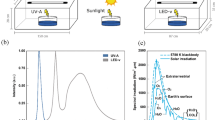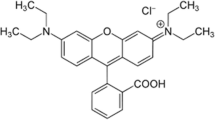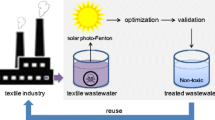Abstract
In this study, photo-Fenton systems using visible light sources with iron and ferrioxalate were tested for the DOC degradation and decolorization of textile wastewater. Textile wastewaters originated after the dyeing stage of dark-colored tissue in the textile industry, and the optimization of treatment processes was studied to produce water suitable for reuse. Dissolved organic carbon, absorbance, turbidity, anionic concentrations, carboxylic acids, and preliminary cost analysis were performed for the proposed treatments. Conventional photo-Fenton process achieved near 99 % DOC degradation rates and complete absorbance removal, and no carboxylic acids were found as products of degradation. Ferrioxalate photo-Fenton system achieved 82 % of DOC degradation and showed complete absorbance removal, and oxalic acid has been detected through HPLC analysis in the treated sample. In contrast, photo-peroxidation with UV light was proved effective only for absorbance removal, with DOC degradation efficiency near 50 %. Treated wastewater was compared with reclaimed water and had a similar quality, indicating that these processes can be effectively applied for textile wastewater reuse. The results of the preliminary cost analysis indicated costs of 0.91 to 1.07 US$ m−3 for the conventional and ferrioxalate photo-Fenton systems, respectively.

ᅟ





Similar content being viewed by others
References
Ahmad AA, Hameed BH (2010) Effect of preparation conditions of activated carbon from bamboo waste for real textile wastewater. J Hazard Mater 173:487–493
Alaton IA, Balcioglu IA, Bahnemann DW (2002) Advanced oxidation of a reactive dyebath effluent: comparison of O3, H2O2/UV-C and TiO2/UV-A processes. Water Res 36:1143–1154
Amorim CC, Leão MMD, Moreira RFPM, Fabris JD, Henriques AB (2013) Performance of blast furnace waste for azo dye degradation through photo-Fenton-like processes. Chem Eng J 224:59–66
APHA, AWWA, WEF (2005) Standard methods for the examination of water and wastewater. APHA, Washington
Arslan-Alaton I, Tureli G, Olmez-Hanci T (2009) Treatment of azo dye production wastewaters using photo-Fenton-like advanced oxidation processes: optimization by response surface methodology. J Photochem Photobiol A Chem 202:142–153
Blanco J, Torrades F, De la Varga M, García-Montaño J (2012) Fenton and biological-Fenton coupled processes for textile wastewater treatment and reuse. Desalination 286:394–399
Blanco J, Torrades F, Morón M, Brouta-Agnésa M, García-Montaño J (2014) Photo-Fenton and sequencing batch reactor coupled to photo-Fenton processes for textile wastewater reclamation: feasibility of reuse in dyeing processes. Chem Eng J 240:469–475
Carneiro PA, Nogueira RFP, Zanoni MVB (2007) Homogeneous photodegradation of C.I. Reactive Blue 4 using a photo-Fenton process under artificial and solar irradiation. Dyes Pigments 74:127–132
Carra I, Casas López JL, Santos-Juanes L, Malato S, Sánchez Pérez JA (2013) Iron dosage as a strategy to operate the photo-Fenton process at initial neutral pH. Chem Eng J 224:67–74
Chong MN, Sharma AK, Burn S, Saint CP (2012) Feasibility study on the application of advanced oxidation technologies for decentralised wastewater treatment. J Clean Prod 35:230–238
Constapel M, Schellenträger M, Marzinkowski JM, Gäb S (2009) Degradation of reactive dyes in wastewater from the textile industry by ozone: analysis of the products by accurate masses. Water Res 43:733–743
Dias IN, Souza BS, Pereira JHOS, Moreira FC, Dezotti M, Boaventura RAR, Vilar VJP (2014) Enhancement of the photo-Fenton reaction at near neutral pH through the use of ferrioxalate complexes: a case study on trimethoprim and sulfamethoxazole antibiotics removal from aqueous solutions. Chem Eng J 247:302–313
dos Santos AB, Cervantes FJ, van Lier JB (2007) Review paper on current technologies for decolourisation of textile wastewaters: perspectives for anaerobic biotechnology. Bioresour Technol 98:2369–2385
Doumic LI, Soares PA, Ayude MA, Cassanello M, Boaventura RAR, Vilar VJP (2015) Enhancement of a solar photo-Fenton reaction by using ferrioxalate complexes for the treatment of a synthetic cotton-textile dyeing wastewater. Chem Eng J 277:86–96
Forgacs E, Cserháti T, Oros G (2004) Removal of synthetic dyes from wastewaters: a review. Environ Int 30:953–971
Gernjak W, Krutzler T, Glaser A, Malato S, Caceres J, Bauer R, Fernández-Alba AR (2003) Photo-Fenton treatment of water containing natural phenolic pollutants. Chemosphere 50:71–78
Gogate PR, Pandit AB (2004) A review of imperative technologies for wastewater treatment I: oxidation technologies at ambient conditions. Adv Environ Res 8:501–551
Grčić I, Maljković M, Papić S, Koprivanac N (2011) Low frequency US and UV-A assisted Fenton oxidation of simulated dyehouse wastewater. J Hazard Mater 197:272–284
Hernández-Rodríguez MJ, Fernández-Rodríguez C, Doña-Rodríguez JM, González-Díaz OM, Zerbani D, Pérez Peña J (2014) Treatment of effluents from wool dyeing process by photo-Fenton at solar pilot plant. J Environ Chem Eng 2:163–171
ICIS (2015): ICIS Pricing
Kalbar PP, Karmakar S, Asolekar SR (2013) The influence of expert opinions on the selection of wastewater treatment alternatives: a group decision-making approach. J Environ Manag 128:844–851
Kalsoom U, Ashraf SS, Meetani MA, Rauf MA, Bhatti HN (2012) Degradation and kinetics of H2O2 assisted photochemical oxidation of Remazol Turquoise Blue. Chem Eng J 200–202:373–379
Khandegar V, Saroha AK (2013) Electrocoagulation for the treatment of textile industry effluent–a review. J Environ Manag 128:949–963
Lu X, Liu L, Liu R, Chen J (2010) Textile wastewater reuse as an alternative water source for dyeing and finishing processes: a case study. Desalination 258:229–232
Mahamuni NN, Adewuyi YG (2010) Advanced oxidation processes (AOPs) involving ultrasound for waste water treatment: a review with emphasis on cost estimation. Ultrason Sonochem 17:990–1003
Malato S, Fernández-Ibáñez P, Maldonado MI, Blanco J, Gernjak W (2009) Decontamination and disinfection of water by solar photocatalysis: recent overview and trends. Catal Today 147:1–59
Manenti DR, Módenes AN, Soares PA, Espinoza-Quiñones FR, Boaventura RAR, Bergamasco R, Vilar VJP (2014) Assessment of a multistage system based on electrocoagulation, solar photo-Fenton and biological oxidation processes for real textile wastewater treatment. Chem Eng J 252:120–130
Manenti DR, Soares PA, Módenes AN, Espinoza-Quiñones FR, Boaventura RAR, Bergamasco R, Vilar VJP (2015) Insights into solar photo-Fenton process using iron(III)–organic ligand complexes applied to real textile wastewater treatment. Chem Eng J 266:203–212
Marcelino RBP, Queiroz MTA, Amorim CC, Leão MMD, Brites-Nóbrega FF (2015) Solar energy for wastewater treatment: review of international technologies and their applicability in Brazil. Environ Sci Pollut Res 22:762–773
Módenes AN, Espinoza-Quiñones FR, Manenti DR, Borba FH, Palácio SM, Colombo A (2012) Performance evaluation of a photo-Fenton process applied to pollutant removal from textile effluents in a batch system. J Environ Manag 104:1–8
Monteagudo JM, Durán A, Corral JM, Carnicer A, Frades JM, Alonso MA (2012) Ferrioxalate-induced solar photo-Fenton system for the treatment of winery wastewaters. Chem Eng J 181–182:281–288
Moreira FC, Garcia-Segura S, Vilar VJP, Boaventura RAR, Brillas E (2013) Decolorization and mineralization of Sunset Yellow FCF azo dye by anodic oxidation, electro-Fenton, UVA photoelectro-Fenton and solar photoelectro-Fenton processes. Appl Catal B Environ 142–143:877–890
Poole AJ (2004) Treatment of biorefractory organic compounds in wool scour effluent by hydroxyl radical oxidation. Water Res 38:3458–3464
Rodrigues CSD, Madeira LM, Boaventura RAR (2013) Optimization and economic analysis of textile wastewater treatment by photo-Fenton process under artificial and simulated solar radiation. Ind Eng Chem Res 52:13313–13324
Rosa JM, Fileti AMF, Tambourgi EB, Santana JCC (2015) Dyeing of cotton with reactive dyestuffs: the continuous reuse of textile wastewater effluent treated by ultraviolet / hydrogen peroxide homogeneous photocatalysis. J Clean Prod 90:60–65
Rosso JA, Rodríguez Nieto FJ, Gonzalez MC, Mártire DO (1998) Reactions of phosphate radicals with substituted benzenes. J Photochem Photobiol A Chem 116:21–25
Salazar R, Garcia-Segura S, Ureta-Zañartu MS, Brillas E (2011) Degradation of disperse azo dyes from waters by solar photoelectro-Fenton. Electrochim Acta 56:6371–6379
Soares PA, Batalha M, Souza SMAGU, Boaventura RAR, Vilar VJP (2015) Enhancement of a solar photo-Fenton reaction with ferric-organic ligands for the treatment of acrylic-textile dyeing wastewater. J Environ Manag 152:120–131
Soon AN, Hameed BH (2011) Heterogeneous catalytic treatment of synthetic dyes in aqueous media using Fenton and photo-assisted Fenton process. Desalination 269:1–16
Souza BM, Dezotti MWC, Boaventura RAR, Vilar VJP (2014) Intensification of a solar photo-Fenton reaction at near neutral pH with ferrioxalate complexes: a case study on diclofenac removal from aqueous solutions. Chem Eng J 256:448–457
Tarr MA (2003): Chemical degradation methods for wastes and pollutants–environmental and industrial applications, CRC Press, New York
Vajnhandl S, Majcen Le Marechal A (2005) Ultrasound in textile dyeing and the decolouration/mineralization of textile dyes. Dyes Pigments 65:89–101
Vajnhandl S, Valh JV (2014) The status of water reuse in European textile sector. J Environ Manag 141:29–35
Vedrenne M, Vasquez-Medrano R, Prato-Garcia D, Frontana-Uribe BA, Hernandez-Esparza M, de Andrés JM (2012) A ferrous oxalate mediated photo-Fenton system: toward an increased biodegradability of indigo dyed wastewaters. J Hazard Mater 243:292–301
Verma AK, Dash RR, Bhunia P (2012) A review on chemical coagulation/flocculation technologies for removal of colour from textile wastewaters. J Environ Manag 93:154–168
Vilar VJP, Pinho LX, Pintor AMA, Boaventura RAR (2011) Treatment of textile wastewaters by solar-driven advanced oxidation processes. Sol Energy 85:1927–1934
Vilar VJP, Moreira FC, Ferreira ACC, Sousa MA, Gonçalves C, Alpendurada MF, Boaventura RAR (2012) Biodegradability enhancement of a pesticide-containing bio-treated wastewater using a solar photo-Fenton treatment step followed by a biological oxidation process. Water Res 46:4599–4613
Wang X, Zeng G, Zhu J (2008) Treatment of jean-wash wastewater by combined coagulation, hydrolysis/acidification and Fenton oxidation. J Hazard Mater 153:810–816
Acknowledgements
The authors would like to thank FAPEMIG, CAPES, CNPQ, and BNDES for their financial support and the textile industry for their trustworthy collaboration.
Author information
Authors and Affiliations
Corresponding author
Additional information
Responsible editor: Bingcai Pan
Rights and permissions
About this article
Cite this article
Starling, M.C.V.M., Castro, L.A.S., Marcelino, R.B.P. et al. Optimized treatment conditions for textile wastewater reuse using photocatalytic processes under UV and visible light sources. Environ Sci Pollut Res 24, 6222–6232 (2017). https://doi.org/10.1007/s11356-016-6157-8
Received:
Accepted:
Published:
Issue Date:
DOI: https://doi.org/10.1007/s11356-016-6157-8




